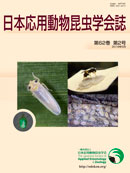
- Issue 4 Pages 215-
- Issue 3 Pages 137-
- Issue 2 Pages 95-
- Issue 1 Pages 1-
- |<
- <
- 1
- >
- >|
-
Ken Funayama2018Volume 62Issue 2 Pages 95-105
Published: May 25, 2018
Released on J-STAGE: July 10, 2018
JOURNAL FREE ACCESSDownload PDF (954K)
-
Shinichi Masui2018Volume 62Issue 2 Pages 107-114
Published: May 25, 2018
Released on J-STAGE: July 10, 2018
JOURNAL FREE ACCESSI investigated the impact of insecticide application on the population density of Panonychus citri(McGregor)in two citrus orchards in Shizuoka Prefecture with different species of mite predators. In one citrus orchard, Neoseiulus californicus(McGregor)was the main mite predator species. The application of tolfenpyrad reduced the density of N. californicus and resulted in an increase of P. citri, whereas the application of imidacloprid or chlorfenapyr did not affect the densities of N. californicus and P. citri. In the other citrus orchard, Stethorus spp. were the main mite predator. The application of imidacloprid reduced the density of the predators and increased the density of P. citri, whereas the application of chlorfenapyr did not affect the density of P. citri and the predators. The application of tolfenpyrad reduced the density of the predators, but P. citri did not increase. These results demonstrate that biological control of P. citri requires careful selection of insecticides that will not have a detrimental effect on the region-specific species of mite predators in citrus orchards.
View full abstractDownload PDF (653K) -
Takeshi Kamimuro, Shoko Higashitarumizu, Hiroshi Suenaga2018Volume 62Issue 2 Pages 115-121
Published: May 25, 2018
Released on J-STAGE: July 10, 2018
JOURNAL FREE ACCESSWe conducted a laboratory investigation on the growth, copulation and egg-laying behavior of the tea leafroller Caloptilia theivora(Walsingham), a serious pest of tea plants in Japan. The aim of the study was to obtain basic information that can be used to control the tea leafroller. When reared at 24°C, adult males emerged earlier than adult females by 1.5 days. On the day of emergence, adult females copulated, but males did not. These observations suggest that males have adopted a mating strategy in which they emerge earlier than females and become sexually mature before females emerge. Next, we investigated the influence of copulation frequency on the adult longevity and number of eggs laid by females. Males and females kept virgin for their entire life lived significantly longer than those allowed to mate. Males and females copulated repeatedly during their entire life when allowed to mate freely; females exposed to males for life laid more eggs than those exposed to a male for one day. Females laid eggs between 22:00 and 24:00. These findings may be used to develop a management strategy against the tea leafroller using mating disruption with synthetic sex pheromones and disturbance of oviposition by lighting.
View full abstractDownload PDF (570K)
-
Tsuyoshi Ohishi, Atsushi Honma, Chihiro Himuro, Kiyohito Teruya2018Volume 62Issue 2 Pages 123-126
Published: May 25, 2018
Released on J-STAGE: July 10, 2018
JOURNAL FREE ACCESSTo improve the larval artificial diet in a mass-rearing system of Euscepes postfasciatus(Fairmaire), we compared the yield and quality of weevils reared on artificial diets containing different types and amounts of commercial sweet potato powder, using their current diet as the control(made from peeled tubers). We compared a diet containing the same amount of an alternative sweet potato powder(made from the peel of tubers), a diet containing half the amount of the alternative sweet potato powder, and a diet containing no sweet potato powder. The resulting numbers of emerged adults, mean male mass, and rate of sexually matured females did not differ significantly between the diets. Moreover, the mass of females reared on a diet with half the amount of alternative sweet potato powder showed no significant difference from those reared on the control. However, the males reared on the control transferred significantly less sperm than those reared on the other diets. These results indicated that the diet with half the amount of alternative sweet potato powder was superior in terms of yield, quality, and production cost in the weevil mass-rearing system.
View full abstractDownload PDF (430K)
-
2018Volume 62Issue 2 Pages 127-128
Published: May 25, 2018
Released on J-STAGE: July 10, 2018
JOURNAL FREE ACCESSDownload PDF (279K) -
2018Volume 62Issue 2 Pages 129-133
Published: May 25, 2018
Released on J-STAGE: July 10, 2018
JOURNAL FREE ACCESSDownload PDF (701K) -
2018Volume 62Issue 2 Pages 133-134
Published: May 25, 2018
Released on J-STAGE: July 10, 2018
JOURNAL FREE ACCESSDownload PDF (496K) -
2018Volume 62Issue 2 Pages 135
Published: May 25, 2018
Released on J-STAGE: July 10, 2018
JOURNAL FREE ACCESSDownload PDF (96K) -
2018Volume 62Issue 2 Pages 136
Published: May 25, 2018
Released on J-STAGE: July 10, 2018
JOURNAL FREE ACCESSDownload PDF (133K) -
2018Volume 62Issue 2 Pages H21
Published: May 25, 2018
Released on J-STAGE: July 10, 2018
JOURNAL FREE ACCESSDownload PDF (506K) -
2018Volume 62Issue 2 Pages H22
Published: May 25, 2018
Released on J-STAGE: July 10, 2018
JOURNAL FREE ACCESSDownload PDF (235K) -
2018Volume 62Issue 2 Pages H23
Published: May 25, 2018
Released on J-STAGE: July 10, 2018
JOURNAL FREE ACCESSDownload PDF (162K) -
2018Volume 62Issue 2 Pages H24
Published: May 25, 2018
Released on J-STAGE: July 10, 2018
JOURNAL FREE ACCESSDownload PDF (64K)
- |<
- <
- 1
- >
- >|